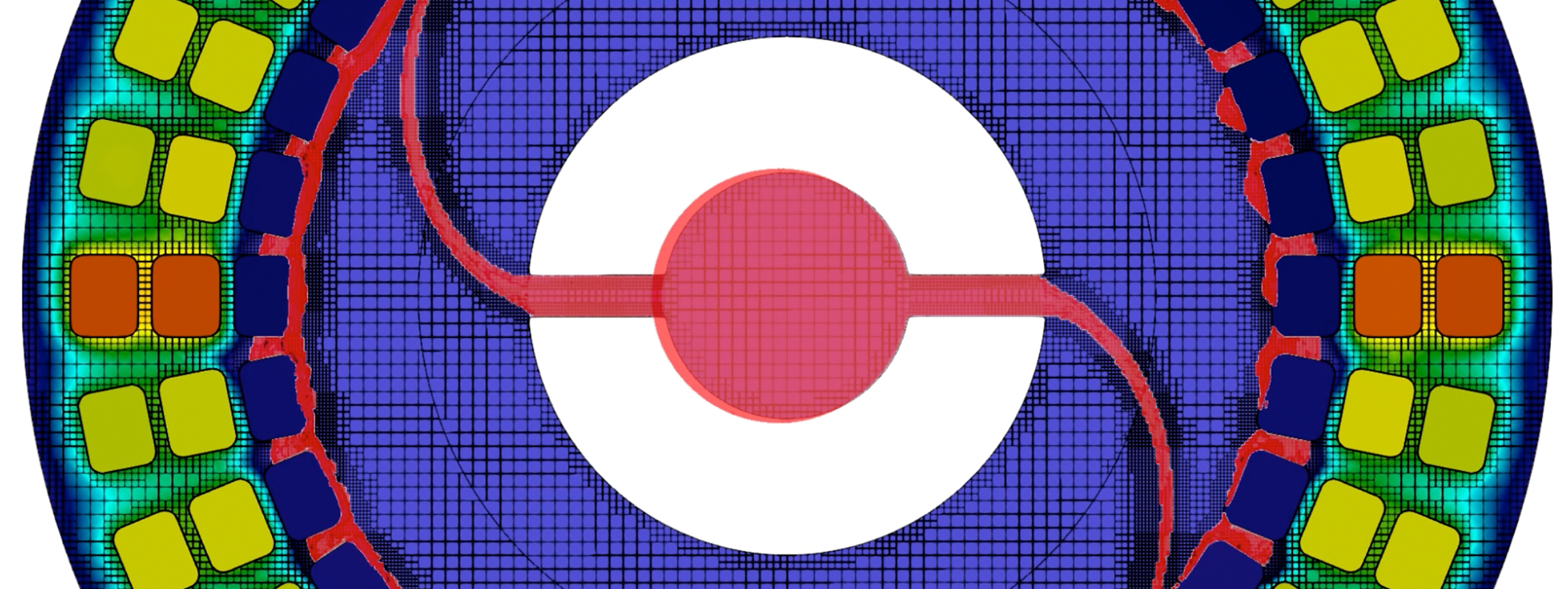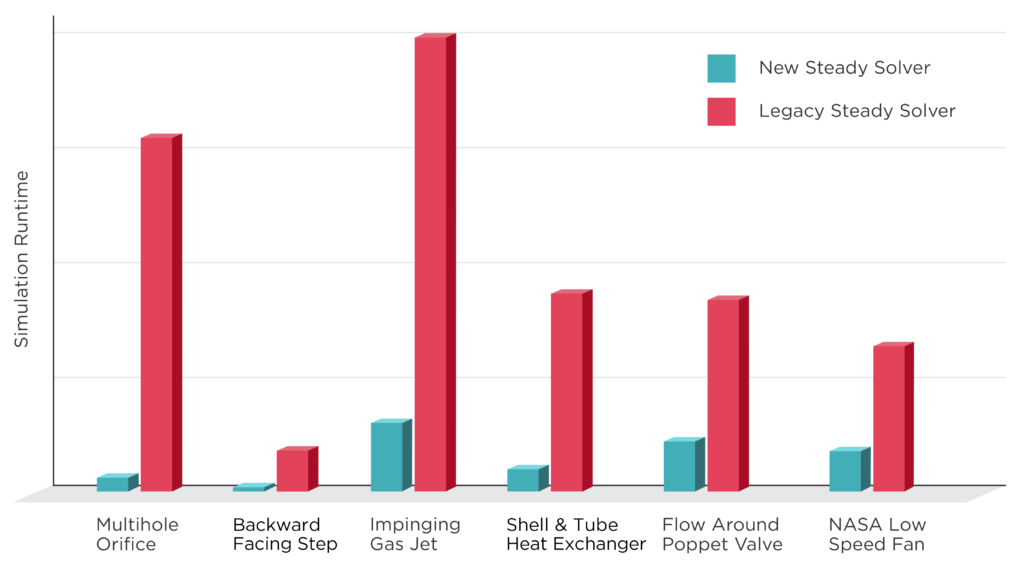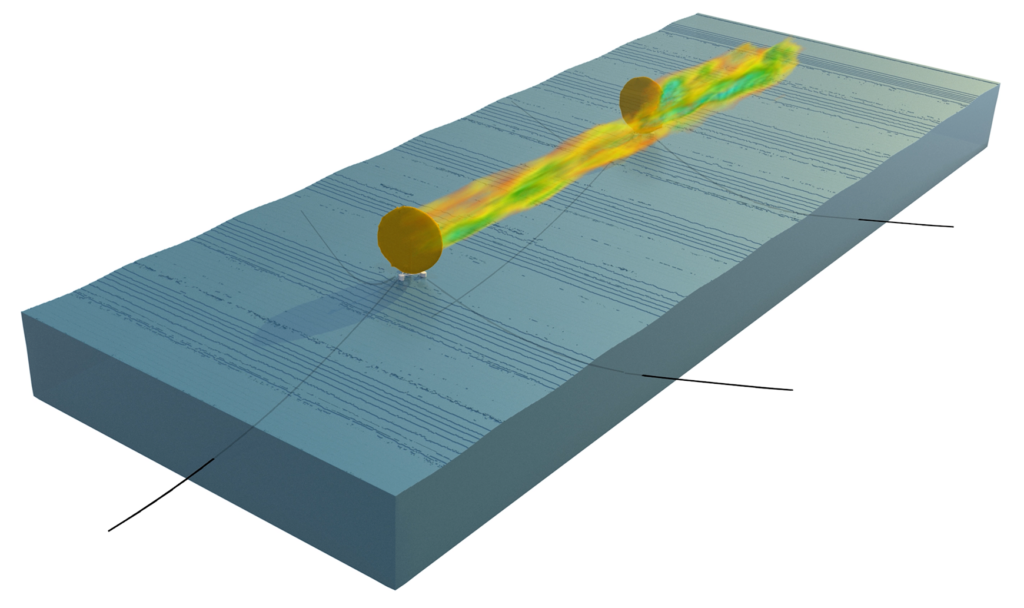
CONVERGE is a leading computational fluid dynamics (CFD) software package with an emphasis on accuracy, efficiency, and innovation. With truly autonomous meshing, state-of-the-art physical models, and the ability to easily accommodate complex moving geometries, CONVERGE is fully equipped to help you solve the hard problems.
Innovative Meshing
CONVERGE features fully autonomous meshing, which eliminates all user meshing time from the simulation process. In addition, CONVERGE’s novel cut-cell approach perfectly represents your geometry—no matter how complex—and easily accommodates moving boundaries. This approach avoids the numerical viscosity generated by deforming meshes and offers accurate results without intensive hands-on setup. Moreover, Adaptive Mesh Refinement allows you to efficiently achieve the best solution possible for a given computational expense by adding cells when and where they are needed to resolve key flow phenomena.
Capture Essential Physical Processes
Going beyond a visually appealing simulation to obtaining useful, realistic results requires accurate physical modeling. CONVERGE contains an extensive suite of well-validated physical models for simulating everything from fluid-structure interaction and conjugate heat transfer to spray and combustion. In addition, CONVERGE includes the SAGE detailed chemistry solver, which is fully coupled with the flow solver for maximum accuracy and efficiency. If you’re interested in implementing a custom model, you can easily do so through user defined functions (UDFs) to customize CONVERGE to meet your needs.
Accelerate R&D
CONVERGE is designed to simplify and expedite the research and design process for an expansive range of applications, from gas turbine engines to mechanical heart valves. With CONVERGE, you can perform a comprehensive system analysis and optimization to find the best design before building an expensive physical prototype. Since 3D CFD simulations can require long runtimes, CONVERGE enables highly parallel simulations on many processors and demonstrates excellent scaling even on thousands of cores. Taking advantage of these capabilities can drastically reduce time-to-solution for your simulations. Overall, incorporating CONVERGE into your R&D workflow can reduce costs across the board and enable you to bring your product to market sooner.
What’s New in CONVERGE 4?
CONVERGE 4, the latest major release of our CFD software, includes many exciting new features and enhancements that expand both the capability and usability of the code.
Speed & Accuracy Improvements
Under-Relaxation Steady Solver
CONVERGE 4 introduces a new Under-Relaxation Steady (URS) solver, which offers a number of benefits for steady-state simulations. Instead of using time marching to reach steady state, as the pseudo-transient solver does, the URS solver uses under-relaxation in place of the transient term. With this scheme, the residuals often converge much faster, significantly reducing runtime. Depending on the application, the URS solver can be approximately 3–100 times faster than the pseudo-transient solver.

2D Axisymmetric Solver
With the new 2D axisymmetric solver, you can solve 3D problems with axisymmetric characteristics using a cylindrical framework. Compared to solving these problems in Cartesian coordinates with sector geometries, the 2D axisymmetric solver offers improved spatial accuracy and substantially reduced computational cost. You can use this feature with the transient, pseudo-transient, or URS solvers.
Cross-Stream Synchronization
Previous versions of CONVERGE allowed you to use different physical models and solver settings in different streams, i.e., different sub-domains of the simulation. CONVERGE 4 adds the capability to use different time-steps in different streams, which are then synchronized at a user-specified time interval. This enhancement can accelerate transient simulations in which the time-scales are very different for different streams and strong coupling between the streams is not required to adequately predict flow behavior, for example, in some conjugate heat transfer simulations.
Enhanced Modeling Capabilities
Combustion & Chemistry Modeling
CONVERGE 4 includes enhancements to several combustion models. The Extended Coherent Flame Model (ECFM) and 3-Zone Extended Coherent Flame Model (ECFM3Z) have been expanded to be compatible with hydrogen and ammonia fuels. Furthermore, the thickened flame model (TFM), previously available for use with large eddy simulations (LES), can now be used with Reynolds-Averaged Navier-Stokes (RANS) simulations as well. For hydrogen combustion, where the flame thickness is very thin, and for other fuels operating under high pressures, this feature allows you to track the flame front at a much lower computational cost.
In addition to these model enhancements, CONVERGE 4 also includes a new spark model, the Lagrangian-Eulerian Spark Ignition (LESI) model. The LESI model provides a more realistic approach to simulate spark ignition by modeling the arc/glow phase as a segmented line that interacts with the flow. Users also have the option to include sub-models to predict blowout, restrike, and short-circuiting.
In CONVERGE 4, the SAGE detailed chemistry solver can be used to model liquid-phase and solid-phase chemistry. Combining liquid-phase chemistry modeling with the volume of fluid (VOF) dissolved gas model allows you to study processes such as carbon sequestration, ocean acidification, and pollution control devices for industrial gas streams. Using the solid-phase chemistry feature, you can model a reactive solid that undergoes thermochemical decomposition when exposed to an external heat source. Applications of solid-phase chemistry include biomass fuel pyrolysis (e.g., wildfires) and battery reactions occurring during thermal runaway.
CONVERGE’s chemistry tools have also been improved in version 4. The surrogate blender tool can help you find the optimal mixture composition of a multi-component surrogate to match the properties of a complex target fuel. Updates have been made to the tool to increase the accuracy of the surrogate fuel properties. The mechanism tuning and reduction tools, which have been available for several years with limited 0D and 1D targets, have been upgraded to allow unlimited targets, including soot emissions. Furthermore, CONVERGE 4 includes a new chemistry tool, the 1D spherical flame solver. This solver calculates the Markstein length, an important parameter for modeling the effects of curvature on laminar flamespeed. Modeling these effects may be important for some premixed combustion cases, such as hydrogen combustion.
Multi-Phase Modeling
The Multi-Fluid Multi-Field (MFMF) model in CONVERGE 4 allows you to model multiple interspersed phases, which can be liquids, gases, or even small solid particles that can be reasonably modeled as a continuum. All phases share a single pressure field but can have separate velocity fields. Continuity and momentum equations are solved for each phase, and they are coupled by interphase momentum exchange terms such as drag, lift, and virtual mass. The MFMF model is useful for many applications in the oil and gas industry, for example, simulating oil separators, fluidized beds, granular flows, and the complexities of multi-phase pipe flow regimes.
The drift flux model, introduced in CONVERGE 3.1, can now be used in porous media. This feature can model two-phase flow within heterogenous porous media, where each phase responds differently due to inertial, viscous, capillary, and interfacial forces. This model can be applied to applications including polymer electrolyte membrane (PEM) fuel cells, geologic carbon sequestration, and gas hydrate formation in sediment.
CONVERGE 4 also includes a new boiling model, the Lee model, which was implemented in collaboration with IFP Energies nouvelles. This model is implemented in the VOF framework, and treats the liquid-vapor-gas mixture as a single fluid in the CFD cell. The Lee model is inexpensive and capable of simulating large-scale industrial problems.
Several popular homogeneous mixture-based cavitation models have been implemented in CONVERGE 4: the Saito, Singhal, and Schneer and Sauer models. These models are relatively simple and efficient, assuming a homogeneous mixture in each CFD cell. They span the spectrum of stability and accuracy, so you can choose the model that works best for your case. These models are particularly useful for marine applications, such as ship propellers, as well as pumps, compressors, and other turbomachinery.
A variety of tools for wind and wave specification, available as UDFs in previous versions, have been integrated into the main code in version 4. With these tools, CONVERGE can generate both regular and irregular water waves using various wave theories. To reduce numerical wave reflections, you can include wave relaxation zones at the inlet and outlet that act as sink terms for momentum and mass. In addition, you can introduce a wind profile above the water, and CONVERGE will couple the wind and waves using its VOF method for multi-phase modeling. These tools are critical for conducting realistic marine and offshore simulations.
Discrete Phase Modeling
CONVERGE 4 offers two new condensation models to predict the conversion of a gas species into liquid parcels as a function of pressure and temperature. The drop condensation model simulates condensation onto the surfaces of existing liquid drops, for example, the condensation of fuel vapor onto spray parcels. The nucleation model simulates condensation onto particulate matter that exists in the Eulerian fluid, for example, cloud formation on wingtip vortices.
CONVERGE’s capabilities for modeling urea deposits have also been enhanced in version 4. Simulating the buildup of urea deposits is of interest for aftertreatment systems, but accurately predicting the location and size of the deposits is challenging. CONVERGE 4 introduces a model that can isolate solid urea byproducts and have them stick to the boundaries, while the rest of the liquid film parcels move forward. A new local surface deformation motion type was implemented that can capture the growth of urea deposits, among other applications. The MORPH feature interpolates the boundary-face-based displacement onto the triangle vertices and moves them accordingly. This mimics the real-world behavior of urea deposits, which, as they grow, interact with the flow and impact the location of subsequent deposits and downstream flow features.
Another new capability introduced in CONVERGE 4 allows parcels to be modeled in a multiple reference frame (MRF) simulation. The MRF approach simplifies simulations that include moving geometries by modeling the moving geometry as stationary. The user specifies a region of the domain as a local rotating reference frame, which moves relative to the stationary, or inertial, reference frame. CONVERGE uses a rotation correction to ensure the parcels enter and leave the rotating reference frame at the correct locations and takes into account the fictitious forces experienced by the parcels in the rotating reference frame. An example application of this feature is predicting sensor fouling in a turbocharger inlet duct.
Electrochemical Modeling
The electric potential solver, which can be used to predict the current and associated heat transfer for direct current applications, has been enhanced in CONVERGE 4. Now, you can use this feature to solve for two coupled electric potential fields, one for the anode side and one for the cathode side of a battery. The two electric potential fields are coupled through a source term, which is provided via the single particle electrochemical model—another new feature in version 4. The single particle model is appropriate for modeling Lithium-ion battery packs, commonly used in electric vehicles. These features can be used to model the heat generation of a battery pack to study different cooling methods and to investigate the charging and discharging processes.

Engineering Models
Thin-Gap Model
CONVERGE 4 offers a thin-gap model based on the Reynolds equation of classical lubrication theory. This model is appropriate for modeling lubrication systems and sealing with leakage, and it can be applied to both stationary and moving boundaries in any orientation. The thin-gap model is useful for applications including bearings and various components of pumps and compressors.
Rotor Models
One of CONVERGE’s defining characteristics is the ease with which it can handle complex moving geometries. However, when simulating applications with rotors, such as wind turbines or quadcopter drones, it can be beneficial to employ simplified models to reduce the computational expense of the simulation. CONVERGE 4 introduces two rotor modeling options: the actuator-line model (ALM) and the rotational actuator-disk model (RADM). ALM models each blade as an actuator line composed of 2D airfoil points, and the aerodynamic forces at each point are derived from tabulated CD-CL profiles. RADM further simplifies the geometry and calculates time-averaged rotational effects. Compared to ALM, RADM allows for coarser mesh resolution and larger time-steps, which results in a reduced computational cost. Given the high efficiency of the model, RADM opens the door to large-scale wind farm studies.
Pre-/Post-Processing Enhancements
CONVERGE Studio, the graphical user interface for CONVERGE, now includes a simplified, customized version of ParaView as a built-in module. ParaView is a popular open-source data analysis and visualization tool, and the ParaView module in CONVERGE Studio has been customized for CONVERGE users’ post-processing needs. Directly load your CONVERGE output files, create plots and graphs, and generate high-quality images and videos to effectively communicate the results of your simulation studies. The addition of the ParaView module makes CONVERGE Studio a one-stop shop for pre- and post-processing your simulations.
On the pre-processing side, a new feature has been implemented that enables users to create custom case setup panels in CONVERGE Studio. The custom panels display a user-defined subset of case setup inputs and parameters, which greatly simplifies the user interface. With this feature, advanced CFD users can generate custom panels for end users who may not be CFD experts, enabling them to easily set up and run specific types of cases.
An option to quadrangulate the surface of your geometry has also been added in version 4. The quadrangular mesh retains surface features and can be created from an input triangular mesh. This option is beneficial for generating a body-fitted inlaid mesh for certain geometries, enhancing stability, accuracy, and convergence.
General Solver Updates
CONVERGE 4 includes a new sliding mesh feature, which enables you to include a non-axisymmetric feature (e.g., a VOF jet, Lagrangian spray, etc.) in an MRF simulation. When simulating a case with a moving geometry, the sliding mesh approach can significantly reduce the simulation runtime while providing results comparable to those of a conventional transient simulation. This feature is useful for applications such as oil-cooled electric motors.
The user-defined function (UDF) framework in CONVERGE 4 has been significantly improved. The new framework simplifies much of the code and provides greater control over when specific functions are executed. In addition, UDFs are easier to maintain in the new framework, which translates to fewer bugs and faster turnaround time for clients on UDF support.
Finally, CONVERGE 4 includes a variety of input and output changes. These include support for post files in the CGNS format, enabling CONVERGE post files to be read by all post-processors that support the CGNS standard; native support for inlaid meshes composed of arbitrary polyhedra in the CGNS format; and significant memory reduction for cases that include an inlaid mesh.






